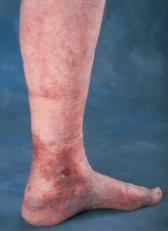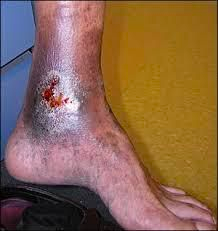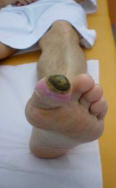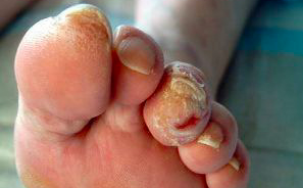If you or a loved one has a wound in the leg, ankle or foot that is not healing normally, it is critical that you insist on getting a vascular ultrasound study. At South Bay Vascular, we have the experience and expertise to offer hope when others say there is none. We can help!
Make an appointment today!
Call 408-376-3626
Symptoms
Non-healing leg wounds and ulcers fall into several different categories, with different symptoms:
- Venous Wounds: Venous ulcers are the most common type and are located in the middle or lower part of the leg, usually above the ankle. These ulcers may be quite large (5-10 cm diameter) and may be “ugly” in appearance, but they are usually not painful. If there is associated pain, the pain is frequently relieved by elevation of the extremity. The skin around these ulcers may be brownish in color and may be firm to the touch (not soft and supple) for many years before the ulcer begins. These types of problems can be treated permanently, and risk of limb loss is low.
- Arterial Wounds: Arterial ulcers are usually very painful. They are most often located in the foot or toes, furthest from the heart. Pain may be worse at night if your foot is not kept below the heart. The wound itself may be small (1-2 cm diameter) and may be just the tip of a toe. The wound is usually dry, and the skin around the wound is sometimes red, tender, and swollen. It is important to get treatment immediately, as risk of limb loss is high.
- Diabetic Wounds: If you have diabetes, you may be prone to foot ulcers since you may not have protective sensation on your feet. Foot ulcers may be caused by excessive pressure or rubbing against the skin that may result from wearing ill-fitting shoes or walking barefoot. It is important to get any wounds checked out immediately, as risk of limb loss is higher for diabetes patients.
Risk Factors
- Diabetes
- Age over 50
- Cigarette smoking
- Hypertension

Solutions
A vascular ultrasound is a non-invasive process and can be done, in most cases, in under an hour. Testing is pain-free and does not involve the use of any drugs or anesthesia. Using simple sound waves, a Registered Vascular Ultrasonographer can easily scan for circulatory deficiencies and provide your physician with the critical information they need to develop a plan for how to best approach healing your wounds.
While podiatrists are the traditional starting point for non-healing leg wounds, only a trained Vascular Surgeon can evaluate and treat the underlying cause of most non-healing wounds: poor circulation. Unfortunately, many times skin supplements, hyperbaric chambers, and wound debridement are the standard treatments for treating non-healing wounds, without consideration of the underlying cause of poor circulation.
If you or anyone you know suffers from long-term non-healing ankle, foot or leg wounds, call 408-376-3626 to schedule an appointment today at South Bay Vascular. Our physicians are the leading wound care experts in the South Bay Area and can evaluate the possibility of undergoing a revascularization procedure to address the root cause of this poor circulation.
For more information about non-healing leg wounds and ulcers, see our blog articles:

“My ugly ulcer healed and my ankles are not swollen anymore. I can wear stockings because I don’t worry my ulcer will bleed, and I’m able to wear my shoes all day without worry of swelling.”
– SBVC patient
“I found Dr. Kokinos to be excellent at explaining, assessing, and treating. It is wonderful to find an excellent doctor who is also a friendly and compassionate person.”
– SBVC patient





